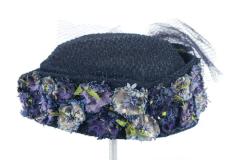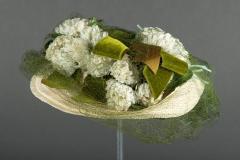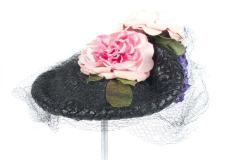Comments and Tags
Be the first to comment on this item!
Voigt Family Collection
Clothing and Accessories
Headwear
Clothing Accessories
Women's Clothing ➔ Hat
Identifier:
V1433.49Description:
This black felt hat features decorative topstitching and a satin bow woven through the felt on the crown. There are two labels on the interior hatband. One reads "French Room, Marshall Field and Company". The second reads "Germaine, New York". This hat was worn by a member of the Voigt family of Grand Rapids, Michigan.Date:
circa 1940Materials:
Felt, SatinDimensions:
5"" h 10"" w 10"" dCurrent Location Status:
In StorageCollection Tier:
Tier 2Source:
Gift Of Kent County Council For Historic PreservationRelated Entities:
Germaine Montabert Inc. (creator)Alternate names: Germaine Millinery Co. , Germaine Montabert
Germaine Montabert was a prominent milliner in New York that was established in 1917. She was located at 711 Fifth Avenue. She created many different styles of hats which were sold at her boutique but also at famous department stores such as Marshall Field and Company. In 1936 the company joined the Millinery Creators Guild and in 1940 the company name changed to Germaine Montabert Inc. The company closed in 1956 when Montabert retired. Kent County Council for Historic Preservation (donor)
The Kent County Council for Historic Preservation has several responsibilities that support the preservation and protection of our history. These include:
- Recommending designation of new historic districts
- Reviewing applications for proposed alterations within historic districts
- Enforcing the Historic Preservation Ordinance Chapter and cooperating with the state, federal and local governments in pursuance of its responsibilities
- Conducting meetings or hearings necessary to carry out these purposes
The Historic Preservation Commission consists of seven members who reside in Grand Rapids. Members are appointed by the City Commission for three-year terms (two consecutive terms are allowed). Members shall have a demonstrated interest in or knowledge of historic preservation. Two members shall be appointed from a list submitted by the Kent County Council for Historic Preservation and one member shall be an architect duly registered in the State of Michigan.
http://grcity.us/design-and-development-services/Planning-Department/Pages/Historic-Preservation-Commission.aspx
Alternate names: Marshall Field, Marshall Field & Co., Marshall Field & Company, Marshall Field's
Marshall Field and Company was founded in 1881 by Marshall Field, however, the business actually began as a dry goods store in 1852 opened by a man named Potter Palmer. In 1865 Field and his partner Levi Z. Leiter took over the business from Palmer and in 1881, renamed the business Marshall Field and Company. Despite the prominence of the Chicago business and loyalty of their customers, the business suffered several tragedies in their early years. During the Great Fire in 1871, employees raced to move the most valuable merchandise from the store to the home of Levi Leiter. The building burnt to the ground, however, due to the quick thinking employees the business was able to operate out of a barn a few days later. The building was rebuilt in 1873 on State Street and expanded upon in 1876, only to be burned down again the following year. The building was again rebuilt and this time remained standing. Field died in 1906 and the business was then successfully taken over by John G. Shedd. In 1913, another scandal hit the store when they were summoned to the state capital for an investigation into the low wages given to female employees Women played a very important role in the business. They served not only as typists and secretaries but also as sales representatives. They had a major part in making female customers feel comfortable in the store and encouraging customers to return. On average the women were paid $2.75 per hour, much under the average pay of $5-$8 per hour. Even in the early 1900s, this was not a living wage. The company refused to raise the pay of these women, which ultimately hindered the business. Throughout the 1920s Marshall Field and Company opened several additional locations in cities such as Lake Forest, Evanston, and Oak Park. The company was bought by the Macy’s corporation in 2006, however many customers remain loyal to Marshall Field & Company today (June 2017) either boycotting Macy’s or petitioning to bring back the original Marshall Field store in downtown Chicago. Voigt House (used by)
Alternate names: Voigt Family
The Voigt family, whose home is now preserved by the Grand Rapids Public Museum, moved to the city in 1875 and resided at 133 Court Street (now Scribner Street). The Voigt family partnered with the Herpolsheimer family in the dry-good and carpet business and in a few years the partnership expanded to include two flour mills -- the Crescent and Star mills located on the Grand River. In 1902 the partnership came to a mutual end. The Herpolsheimer family retained the dry-good store and the Voigt family kept the two mills. By the turn of the century, Voigt flour under several brand names, and later Voigt Cereal, were known across Michigan and far east as New England. Due to bankruptcy and a strike, the flour milling business came to an abrupt end in 1955. In 1895, Carl G.A. Voigt hired local architect William G. Robinson to design a house on 115 College Avenue Southeast to serve as his retirement home. It was modeled after the chateaux at Chenoceaux, France. The home is a fine example of Victorian architecture and complemented the Victorian family that lived in it. It was lived in by just the Voigt family which was comprised of Carl Gustav Adolf Voigt, his wife Elizabeth Wurster Voigt and their children. They were the parents of nine children with six surviving until adulthood. The family lived in the home from 1895 to 1971.


